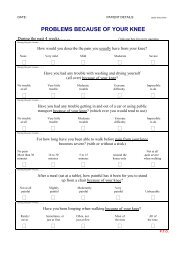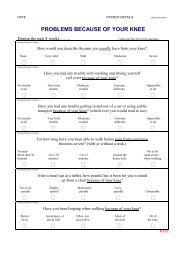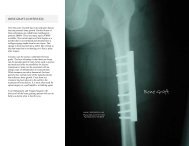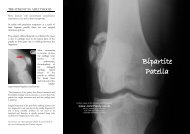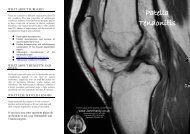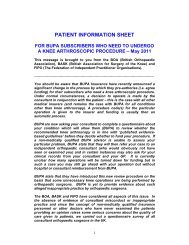Golfers Elbow
Golfers Elbow
Golfers Elbow
You also want an ePaper? Increase the reach of your titles
YUMPU automatically turns print PDFs into web optimized ePapers that Google loves.
WHAT HAPPENS AFTER SURGERY?<br />
You can go home when comfortable. For the first 72<br />
hours, you should rest with your elbow elevated to<br />
reduce swelling. Keep the dressings dry with a<br />
“Limbo” if necessary. You will be seen in the clinic 2<br />
weeks after your operation. The dressings will be<br />
removed, the wound examined and the stitches<br />
removed. You may be prescribed physiotherapy.<br />
Another clinic appointment will be made for 4-6<br />
weeks later.<br />
WHAT ARE THE RISKS?<br />
<strong>Elbow</strong>s always swell up after surgery and can<br />
become stiff. Swelling is part of your body's natural<br />
response to any injury and surgery is no exception.<br />
People vary in how stiff they are after an operation.<br />
Elevation of the limb will help. You can afford to<br />
move the elbow early with the exercises given by the<br />
physiotherapist. The wounds usually heal quickly, but<br />
occasionally these can become infected and need<br />
early suture removal and antibiotics once your doctor<br />
has taken a swab to identify the bacterium.<br />
HOW SOON CAN I?<br />
Go back to work?<br />
This depends on what you do and how you get to<br />
work. If you have a sitting-down job and you can get<br />
to work, you could probably go back to work 1-2<br />
weeks after surgery. On the other hand, if you have a<br />
heavy manual job you may be off for up to 6 weeks.<br />
If you need to drive to work, this will affect when<br />
you can go back. Your surgeon will advise you about<br />
going back to work. Please read the Brochure<br />
“Driving after Surgery” in the same series found at<br />
www.JohnHardy.co.uk.<br />
Play sport?<br />
Before your dressings have been removed you<br />
can start gently exercising your elbow. Everyone<br />
is different in how quickly they can take up<br />
exercise again. Most people can get back to<br />
most of their previous activities within 3<br />
months of Golfer’s elbow release.<br />
Copyright 2000-2008<br />
Copies available from<br />
www.JohnHardy.co.uk<br />
Phone 0044 (0)117 3171796<br />
Fax 0044 (0)117 973 8678<br />
Glofer’s Glofer’s <strong>Elbow</strong><br />
<strong>Elbow</strong><br />
(Medi Medi Medial Medi al<br />
Epicondylitis<br />
Epicondylitis)<br />
Epicondylitis
GOLFER’S ELBOW<br />
(MEDIAL EPICONDYLITIS)<br />
INTRODUCTION<br />
Tendons are cords of living tissue that connect muscles<br />
to bone. They act as the cables that allow joints to move<br />
at a distance from muscular contraction. This gives a<br />
mechanical advantage. Golfer’s elbow is a painful<br />
condition affecting the tendons that attach the muscles<br />
of the front of the forearm to the arm. These muscles<br />
act when gripping in the power grip position. Golfer’s<br />
elbow arises not just from Golfing or using too small or<br />
large a grip on your Golf club. It can be caused by any<br />
repeated twisting movements of the hand and wrist for<br />
example when using a screwdriver. It is common in<br />
patients who have manual occupations. Golfer’s elbow is<br />
also known as medial epicondylitis to doctors. The<br />
condition most commonly occurs in people aged<br />
between 35 and 55. It is most common in males with a<br />
manual occupation. It is most common in the right<br />
hand.<br />
WHAT CAUSES IT?<br />
Predisposing factors to the tendon damage and healing<br />
inflammation that results are rarely a single injury such as<br />
a blow to the arm and more commonly overuse.<br />
Overuse causes microscopic tears in the tendon. Causes<br />
include swimming, gardening, throwing sports and golf.<br />
Also, manual occupations that involve repetitive turning<br />
or lifting the wrist, such as plumbing bricklaying, using<br />
scissors or shears cause it. In attempt to heal the tear<br />
inflammation occurs and it is this inflammation that is<br />
the cause of the pain. Rupture of the tendon<br />
paradoxically results in an earlier cure. Rarely it is caused<br />
by gout (more common if both elbows are affected).<br />
HOW IS IT DIAGNOSED?<br />
There is a clear history of pain first thing in the morning<br />
getting better with exercise. The pain is intermittent at<br />
first but may become continuous and affect sleep. There<br />
may be tenderness over the broad origin of the forearm<br />
muscles on the outside of the elbow. If you have severe<br />
elbow pain, can't move the joint or have any loss of<br />
feeling, you should seek medical treatment urgently. This<br />
may be due to infection of the joint rather than Golfer’s<br />
elbow.<br />
You will not usually be required to undergo X-rays, but<br />
they may be recommended to rule out other conditions,<br />
such as arthritis, that can cause elbow pain. If there is<br />
doubt to the diagnosis then your doctor will suggest an<br />
MRI scan. This gives an image of the soft tissues,<br />
including muscles and tendons, rather than the bones.<br />
HOW IS IT TREATED?<br />
Most people with mild symptoms of Golfer’s elbow can<br />
try conservative treatments like RICE (rest, ice,<br />
compression and elevation). In the acute phase elbow<br />
braces like the Donjoy “Surround” provides both the<br />
compression and the cold therapy if it is kept in the<br />
fridge overnight. Try pain killers, non-steroidal antiinflammatory<br />
drugs like<br />
ibuprofen. Physiotherapy has<br />
been shown to be as effective<br />
as a local anaesthetic, cortisone<br />
injection or elbow braces.<br />
Combine the three and you<br />
have rapid sustained relief.<br />
Your GP may refer you to a<br />
sports medicine doctor or a<br />
physiotherapist. For a Golfer’s<br />
elbow that is persistently painful a doctor may suggest a<br />
steroid injection. Physiotherapy should include exercises,<br />
ultrasound treatment, heat treatment, using an infra-red<br />
lampand help to design a rehabilitation programme.<br />
Most pain will go without any more than the treatments<br />
described within a year.<br />
WHAT ABOUT SURGERY?<br />
Surgical treatment is reserved for those who have severe<br />
pain, persistent symptoms after medical treatment, or<br />
who are at risk of permanent loss of occupation. The<br />
aim is to release the tendon at the elbow. A temporary<br />
tourniquet is used to make the operative field free of<br />
blood. If you are medically fit, have someone who can<br />
collect you and look after you over night after the<br />
operation, the operation can be done on a day case basis.<br />
However, if you have other medical problems such as<br />
diabetes, asthma or high blood pressure, you may have<br />
to stay overnight after surgery.<br />
WILL I HAVE TO HAVE A GENERAL<br />
ANAESTHETIC?<br />
The operation can be done under sedation and local<br />
anaesthetic (asleep). Your anaesthetist will advise you<br />
about the best choice of anaesthetic for you. In addition,<br />
local anaesthetic may be injected into your elbow while<br />
you are asleep to reduce the pain after the operation<br />
even if you go to sleep for the surgery. You will also be<br />
given pain-killing tablets to take home.<br />
WILL I HAVE A PLASTER AFTER?<br />
No, you will not have a plaster on. However, you<br />
may be prescribed or need to buy a Clinical<br />
Shoulder Immobiliser to wear for one or two weeks<br />
after surgery.



